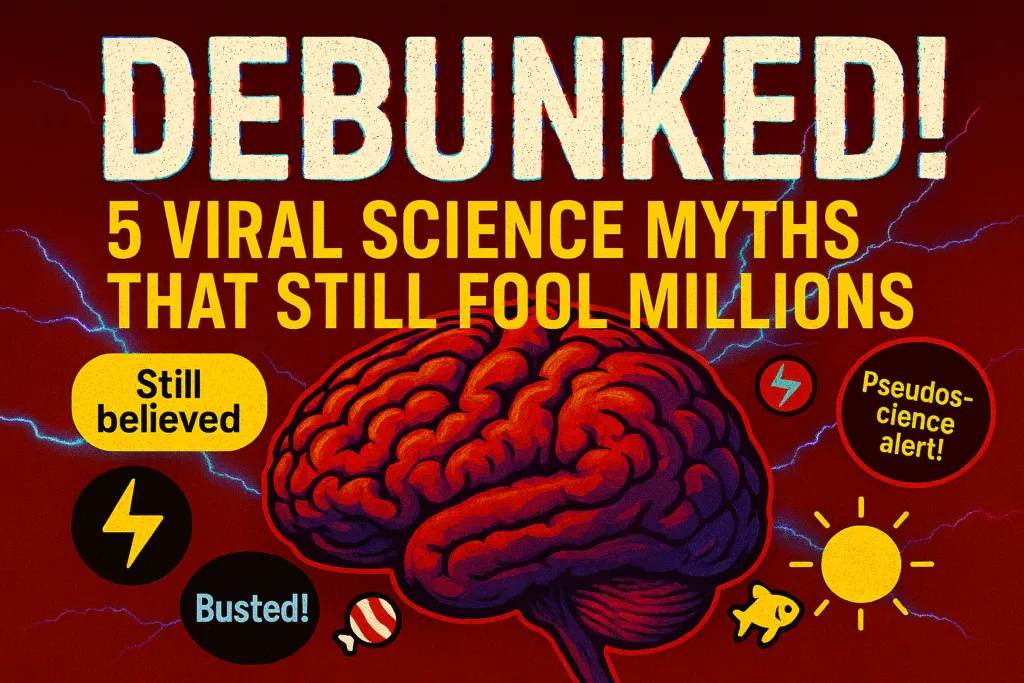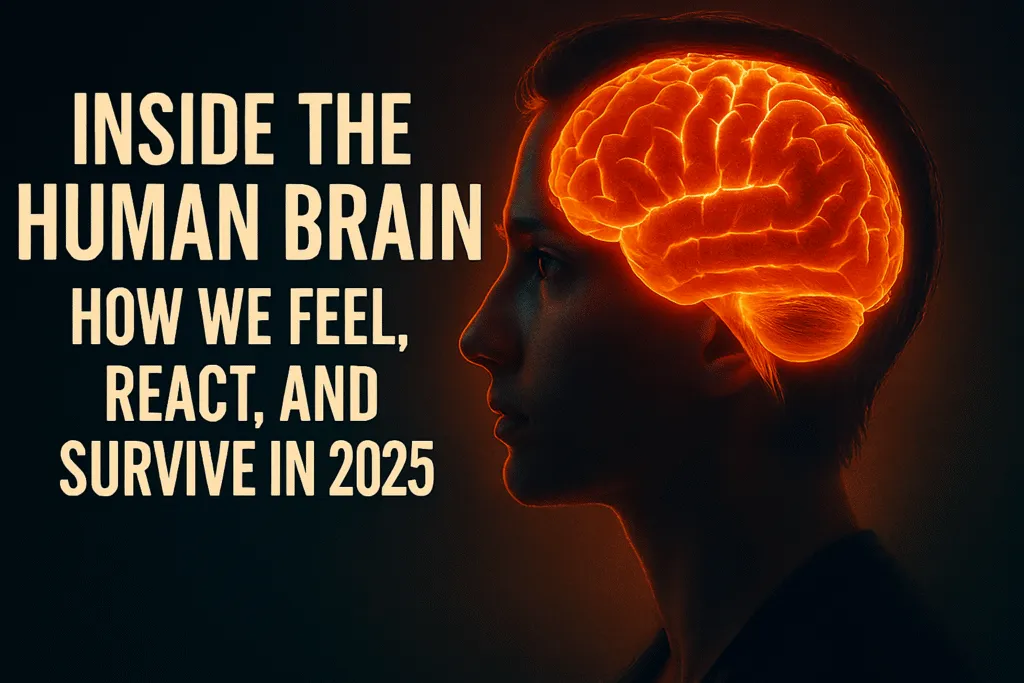Introduction: Why It’s Time to Bust Popular Science Myths
Have you ever believed something your whole life, only to find out it wasn’t true at all? That’s the strange power of science myths. These are the kinds of beliefs that get repeated so often—on social media, in classrooms, or even in casual conversations—that they start to feel like facts. But when we examine them closely using real scientific knowledge, many of these claims completely fall apart.
As a tech blogger, I constantly explore how science and technology influence our lives. Along the way, I’ve come across countless science myths that people accept without question. Whether it’s the idea that humans only use 10% of their brains or that sugar makes kids hyperactive, these myths are everywhere. They may seem harmless, but misinformation can shape public perception, spread confusion, and even slow down scientific progress.
This blog post is dedicated to separating fact from fiction. We’ll take a closer look at five of the most common science myths, uncover the truth behind each one, and explore why it’s so important to challenge what we think we know. If you’re ready to question what you’ve always believed, read on—you might be surprised at what you discover.
Myth #1: Humans Only Use 10% of Their Brain
Among the most popular science myths of all time is the claim that humans use only 10% of their brain. It’s been repeated so often—in movies, motivational talks, and pop culture—that many people assume it must be true. The idea sounds fascinating and full of potential. Imagine unlocking the other 90% and becoming a genius overnight! But here’s the truth: this claim is pure fiction.
Neuroscience has proven time and again that we use virtually all parts of our brain, and that most regions are active almost all the time—even while we sleep. Using advanced imaging tools like fMRI (functional magnetic resonance imaging) and PET scans, researchers have observed activity throughout the brain during everyday tasks such as reading, problem-solving, moving, and even resting. There’s no area of the brain that simply sits unused.
So where did this science myth come from? Some trace it back to early 20th-century psychologists who talked about human potential, not actual brain usage. Others blame misinterpretations of neurological research from that time. It may also have been boosted by self-help gurus who used the “10%” idea to promote their techniques, claiming they could help you unlock hidden mental powers.
But scientifically speaking, the brain is a highly efficient and active organ. It accounts for only about 2% of our body weight but consumes around 20% of the body’s energy. That level of energy usage would be impossible to justify if we were using just a small fraction of our brain. Evolution wouldn’t allow such wastefulness. Every part of the brain serves a purpose, from controlling motor functions to processing emotions and memories.
What’s more, damage to even a small portion of the brain can lead to serious problems—like memory loss, impaired movement, or loss of speech. If 90% of the brain were truly unused, injuries would rarely have any impact. But we know that even minor damage can have major consequences. This fact alone disproves one of the most misleading science myths still circulating today.
So why do people continue to believe it? Like many science myths, this one survives because it’s simple, catchy, and inspiring. It feeds into the idea that we all have untapped potential—that greatness lies within us if only we could access it. While it’s true that most people can improve their skills or mental habits, this doesn’t mean we’re not already using our full brain. It just means we can train it better, much like building physical strength through regular exercise.
Believing this myth can actually be harmful. It encourages people to look for “shortcuts” to intelligence—like miracle brain-boosting pills or unproven memory techniques—rather than focusing on genuine self-improvement through education, rest, and critical thinking. It also undervalues the brain’s existing complexity, making it seem like a half-used machine rather than the incredibly active, integrated system it is.
Understanding the truth behind such science myths helps us appreciate the brain’s real potential—and its limits. There’s no hidden 90% waiting to be unlocked. What we can do is optimize the brain we already use through proper nutrition, exercise, mental stimulation, and lifelong learning.
So next time someone tells you we only use 10% of our brain, you can confidently say that’s just another persistent entry on the long list of popular science myths. Our brains are always working, even when we’re not consciously aware of it. And that, in itself, is far more impressive than any myth could ever be.
Myth #2: Lightning Never Strikes the Same Place Twice
One of the most enduring science myths is the belief that lightning never strikes the same place twice. It’s a phrase many of us have heard since childhood, often used as a metaphor for unlikely events. But while it sounds poetic and reassuring, it’s simply not true—scientifically or statistically.
In fact, lightning can and often does strike the same location multiple times, especially if that place is tall, isolated, or conductive. A prime example is the Empire State Building in New York City, which is struck by lightning around 20 to 25 times per year. Similarly, mountain peaks, radio towers, and other tall structures are repeat targets during thunderstorms. This alone is enough to bust one of the most widely believed science myths.
Lightning follows the path of least resistance, which means it will strike any object that offers an easier route to the ground. Tall, pointy, or metallic objects often become prime targets. If those conditions remain unchanged, lightning has no reason to avoid a previous strike point. In some cases, it may even strike the same place multiple times in one storm, through a process known as multiple return strokes—rapid-fire discharges along the same path.
So why do people still believe this outdated idea? Like many science myths, the “one strike” belief likely emerged from metaphor, not science. It’s often used to suggest that misfortune won’t repeat itself, or that rare events are unlikely to happen again. Over time, this metaphor became mistaken for scientific fact, especially because the average person doesn’t witness lightning hitting the same place repeatedly.
But believing in such science myths isn’t just inaccurate—it can be dangerous. If someone assumes lightning won’t strike a spot again, they might lower their guard during a thunderstorm. That false sense of safety could lead someone to stand near a recently struck tree or metal object, thinking the danger has passed. In reality, lightning is unpredictable, and repeat strikes are a well-documented phenomenon.
Another reason this myth sticks around is due to how people perceive randomness. We often assume that nature behaves like a slot machine—avoiding repetition and spreading out events. But natural phenomena don’t follow human intuition. Lightning, earthquakes, and even weather patterns often defy our expectations. Accepting this helps us better understand the world and separate fact from fiction.
Science and technology have come a long way in monitoring lightning. High-speed photography and lightning detection networks clearly show repeated strikes in the same locations, sometimes within seconds. In fact, many safety systems are designed with this in mind. Tall buildings often have lightning rods that are specifically intended to be struck multiple times. These rods redirect the electrical energy safely into the ground, preventing damage to structures and saving lives.
Understanding how lightning actually behaves not only debunks one of the most persistent science myths, but also highlights the importance of respecting nature’s power. Lightning strikes kill and injure thousands of people globally each year. Most of these incidents occur because people underestimate the threat or misunderstand how lightning works.
So next time someone casually says, “Lightning never strikes the same place twice,” you’ll know it’s just another catchy phrase without any scientific truth. Like many other science myths, it survives because it’s easy to repeat, not because it’s accurate.
The more we challenge these common misconceptions, the closer we get to real knowledge—and better safety. In the end, science myths like this one aren’t just harmless misunderstandings—they’re barriers to understanding how our world truly works. And when it comes to lightning, knowing the truth could save your life.
Myth #3: Sugar Makes Children Hyperactive
Among the most widely believed science myths, one that refuses to go away is the idea that sugar makes children hyperactive. Parents, teachers, and even some doctors have long blamed sugary snacks and desserts for out-of-control energy in kids. The assumption is simple: more sugar equals more energy, which must translate into hyperactivity. But science tells a different story—one that completely debunks this popular myth.
Numerous scientific studies over the years have tested this claim, and the results are surprisingly consistent. Sugar does not cause hyperactivity in children. In controlled experiments where neither the children nor the parents knew whether the child was consuming sugar or a placebo (like a sugar-free drink), there was no significant difference in behavior, attention span, or energy levels. Even children thought to be “sugar sensitive” didn’t show increased hyperactivity.
So, if sugar isn’t the cause, why do so many people still believe this myth? Like many science myths, the answer lies in context and perception. Kids usually consume large amounts of sugar during exciting events—birthday parties, holidays, family gatherings—situations that naturally cause excitement, overstimulation, and high energy. The sugar isn’t making them hyper; the environment is.
There’s also something called the expectancy effect, where belief influences perception. In one study, parents were told their children had consumed sugar (when they actually hadn’t), and those parents reported their kids being more hyperactive. In reality, it was the belief in the myth—not the sugar—that shaped their observations. This is a powerful reminder of how science myths can persist even when disproven.
That said, this doesn’t mean sugar has no effect on the body. Excessive sugar intake can lead to energy spikes and crashes, mood swings, and long-term health issues like obesity and diabetes. But moment-to-moment behavioral changes, like hyperactivity after candy, are not caused by sugar itself. The real factors are usually emotional excitement, lack of sleep, poor diet overall, or underlying conditions such as ADHD.
The danger in accepting such science myths isn’t just the misinformation—it’s the distraction it causes from addressing real concerns. Parents may focus on sugar as the culprit while ignoring other critical factors affecting their child’s behavior, such as screen time, physical activity, emotional stress, or inconsistent sleep schedules. Worse, it may result in unnecessary guilt, frustration, or over-restriction of a child’s diet based on a myth.
Understanding the truth also helps build better communication between parents and children. Rather than blaming sugar for a child’s behavior, parents can look at what’s really going on—Is the child overwhelmed? Overstimulated? Tired? Bored?—and respond with care and understanding, not just dietary control.
Also, this myth has created a market for “sugar-free” or “natural” products that often replace sugar with artificial sweeteners, many of which come with their own health concerns. Chasing the idea that cutting sugar will “calm” a child may lead parents to rely on processed foods that offer no real behavioral benefit.
Ultimately, sugar in moderation is not the enemy, and it definitely doesn’t turn kids into hyperactive tornadoes. It’s time we let go of this outdated idea and stop placing blame where it doesn’t belong. Like many science myths, it survives because it’s easy to believe and hard to challenge—but the evidence is clear.
By staying informed and questioning long-held assumptions, we not only improve our parenting but also model critical thinking for the next generation. And that may be the most powerful thing we can pass on—much more valuable than a slice of birthday cake.
Myth #4: Seasons Are Caused by Earth’s Distance from the Sun
One of the most common science myths still believed by many people is the idea that Earth’s seasons are caused by how close or far the planet is from the Sun. On the surface, this seems logical—after all, we associate warmth with being closer to a heat source. But this explanation, while intuitive, is scientifically incorrect.
In reality, seasons are not caused by the Earth’s distance from the Sun. Instead, they happen because of the tilt of the Earth’s axis. Earth is tilted at about 23.5 degrees relative to the plane of its orbit around the Sun. This tilt, combined with the planet’s yearly orbit, causes different parts of the Earth to receive varying amounts of sunlight throughout the year.
When the Northern Hemisphere is tilted toward the Sun, it experiences summer because the sunlight is more direct and the days are longer. At the same time, the Southern Hemisphere receives less direct sunlight and has shorter days, leading to winter. Six months later, the situation reverses—bringing summer to the Southern Hemisphere and winter to the Northern Hemisphere.
What’s even more surprising is that the Earth is actually closer to the Sun during the Northern Hemisphere’s winter—around early January—and farther during its summer in July. If distance from the Sun truly dictated seasons, we’d expect the opposite climate pattern. This alone should be enough to disprove one of the most persistent science myths out there.
So why do so many people still believe this false explanation? Like many science myths, it’s partly because the real answer is a bit harder to visualize. Understanding axial tilt requires a basic grasp of astronomy and geometry. Most people aren’t taught the full explanation in school or forget it over time, allowing simplified but incorrect ideas to take hold. It also doesn’t help that weather and temperature feel like things we should instinctively understand—so we go with what “feels right,” even if it’s not based on science.
The problem with science myths like this isn’t just that they’re wrong—it’s that they block a deeper understanding of how our planet works. Believing that seasons are caused by distance from the Sun may not seem like a big deal, but it can lead to confusion about more important issues, such as climate change, solar power, or Earth’s atmosphere. These subjects depend on a clear understanding of how sunlight reaches Earth and how energy is distributed across the globe.
What’s truly amazing is how perfectly balanced our seasons are thanks to Earth’s tilt. This natural design affects agriculture, weather, ecosystems, and life cycles in ways that keep our environment stable. Learning the real cause of seasons helps us appreciate just how interconnected and finely tuned our planet really is.
So the next time someone casually explains that winter happens because we’re farther from the Sun, you can confidently tell them it’s just another outdated belief on the long list of science myths. And the more we question these myths, the closer we get to a real understanding of the world around us—one that’s based on evidence, not assumption.
In a world where misinformation spreads quickly, challenging science myths isn’t just about getting the facts right. It’s about cultivating a mindset that values curiosity, accuracy, and truth. And that mindset is exactly what we need to keep exploring the universe with open, informed eyes.
Myth #5: Goldfish Have a 3-Second Memory
Of all the quirky science myths that people casually repeat, one of the most underestimated—and unfair—is the claim that goldfish have a memory span of only three seconds. It’s often used as a joke to describe forgetfulness or short attention spans, but in reality, this myth does a serious disservice to a surprisingly intelligent creature.
Goldfish actually have a memory that lasts much longer than just a few seconds. In fact, scientific studies have shown that goldfish can remember things for weeks, even months. They are capable of learning simple routines, recognizing feeding times, navigating mazes, and even distinguishing between shapes and colors. That’s far beyond the capacity of a creature with just a three-second memory.
This science myth likely became popular because goldfish live in small tanks and repeat the same behaviors, making them seem unaware of their surroundings. Add to that their tiny size and lack of facial expressions, and it’s easy for people to assume there isn’t much going on inside their heads. But the truth is, goldfish are much smarter than they look—and far more aware than we give them credit for.
Researchers have trained goldfish to associate specific sounds with feeding, showing they can form and retain long-term memories. In one experiment, goldfish were taught to press a lever to receive food. Even when the lever was removed and reintroduced weeks later, the fish remembered the task and repeated the behavior. That’s clear evidence of memory retention, pattern recognition, and even problem-solving ability.
So why does this science myth persist? Like many others, it’s catchy, easy to remember, and often used humorously. It’s also a case of humans underestimating animals that don’t display intelligence in ways we can easily recognize. Because goldfish don’t react like dogs, cats, or birds, people assume they lack the capacity to think or remember.
Believing in this kind of misinformation may seem harmless, but it can lead to poor treatment of pets. If people think goldfish have no memory, they may not bother enriching their environment or ensuring consistent care. A bored or stressed goldfish in a tiny, unstimulating tank can suffer just as much as any other neglected pet. Understanding that goldfish have memory and awareness encourages more humane treatment and better tank setups, including space to swim, variation in decor, and interaction with feeding cues.
This also shows the broader harm of science myths. When we oversimplify animal behavior, we miss out on understanding the true complexity of the natural world. Dismissing goldfish as brainless creates a gap between perception and reality—just like other science myths that spread through repetition rather than research.
Goldfish aren’t the only animals that have been misjudged this way. Many species once thought to be unintelligent—like pigeons, crows, and even octopuses—have proven to possess incredible cognitive skills. In fact, studies in animal cognition continue to reveal that intelligence is far more widespread in the animal kingdom than previously believed.
In the end, the “three-second memory” idea is just another item on the long list of science myths that sound right but don’t hold up under scientific scrutiny. By taking the time to question and investigate these claims, we open the door to deeper learning—not just about animals, but about how easily misinformation spreads.
So next time someone jokes about goldfish forgetting everything after a few seconds, you can confidently reply that they’re wrong—and that goldfish might just remember that conversation longer than they do. Because when it comes to science myths, even a tiny fish deserves the truth.
Conclusion: Questioning Science Myths
Science is one of the most powerful tools we have for understanding the world—but it can easily be overshadowed by long-standing misconceptions. From the idea that we only use 10% of our brain to the myth that sugar makes kids hyperactive, science myths are everywhere. They often start as simple misunderstandings or catchy phrases and then get repeated so often that they feel like facts. But repetition doesn’t equal truth.
The problem with science myths isn’t just that they’re wrong—it’s that they shape how people think, learn, and make decisions. When we accept a myth without questioning it, we risk building more beliefs on a false foundation. That can lead to poor choices, misguided fears, and even harmful behavior. Whether it’s assuming lightning won’t strike the same place twice or believing seasons are caused by Earth’s distance from the Sun, these myths prevent us from seeing the real beauty and complexity of science.
The truth is, debunking science myths doesn’t just correct facts—it helps develop critical thinking. It encourages people to ask questions, seek evidence, and think for themselves. That’s what science is truly about. It’s not just a collection of facts; it’s a method—a way of thinking that tests ideas, challenges assumptions, and changes its mind when new evidence appears.
Today, misinformation spreads faster than ever, especially online. Social media, viral videos, and clickbait headlines often oversimplify or distort real science. That’s why it’s so important to pause, investigate, and verify before accepting something as true. When we understand how science myths form and why they persist, we become better equipped to filter out noise and focus on facts.
Another reason science myths are dangerous is that they often downplay the need for real learning. Believing you have a “locked” 90% of brain power to unlock may sound exciting—but it’s far more valuable to understand how your brain actually works and how you can take care of it. Thinking sugar causes hyperactivity may seem harmless, but it distracts from deeper issues like screen time, sleep habits, or mental health. That’s the quiet damage of misinformation—it shifts our focus away from what actually matters.
The good news is that science is always available to anyone who seeks it. You don’t need to be a scientist to ask smart questions or read trustworthy sources. You just need curiosity and a willingness to rethink old ideas. And when you start seeing through these myths, the world becomes a much more interesting place—because you’re not just memorizing facts; you’re truly understanding them.
Let’s not forget that some of the most fascinating scientific truths were once dismissed as ridiculous. It took centuries to accept that Earth revolves around the Sun or that invisible germs could cause disease. Science thrives on challenging what we think we know—and that includes calling out false beliefs like these common science myths.
So as you leave this article, take the spirit of inquiry with you. Challenge the “facts” you’ve always believed. Double-check that viral post before you share it. Teach your kids to ask “why?” instead of just accepting what they’re told. That’s how we all grow—not just as individuals, but as a society rooted in evidence, not assumption.
Because in the end, the biggest myth of all would be thinking we already know everything. Science isn’t about having all the answers—it’s about never stopping the search for better ones. And the more science myths we leave behind, the clearer that path becomes.
Also Read: Time Travel Could Shock the World in 2025—Thanks to This Tiny Physics Glitch
FAQs: Debunking Common Science Myths
Q1. Why do science myths spread so easily?
Science myths often spread because they’re simple, memorable, and repeated often. Many start from misunderstandings, outdated information, or are used as metaphors that people mistake for facts. Without questioning or verifying them, they get passed along as truth for generations.
Q2. Are all science myths harmless?
Not always. While some may seem innocent, many science myths can lead to poor decisions, especially in health, education, and safety. For example, believing that sugar makes kids hyperactive can lead to unnecessary diet restrictions or ignoring more serious behavioral causes.
Q3. How can I tell if something is a science myth or a fact?
Always question the source. Look for scientific studies, expert-reviewed articles, or official institutions like NASA, WHO, or universities. If a claim lacks evidence or contradicts proven science, it may be a myth. Cross-referencing multiple reliable sources is key to separating fact from fiction.
Q4. What’s the harm in believing that humans only use 10% of their brain?
This science myth promotes the false idea that we have “hidden powers” waiting to be unlocked. In reality, we use all parts of our brain regularly. Believing the 10% myth can lead people to buy into pseudoscientific products or ignore how the brain truly works.
Q5. Can science myths affect children’s learning?
Yes. If kids grow up believing incorrect information—like the idea that seasons change due to Earth’s distance from the Sun—they may struggle with more complex scientific topics later. That’s why it’s important to correct science myths early and promote critical thinking.
Q6. Why do people still say “lightning never strikes the same place twice”?
It’s a common saying, but it’s scientifically false. Tall structures like skyscrapers and mountain peaks are often struck multiple times. This is one of the many science myths that stick around because it sounds catchy, even though it’s been debunked by research.
Q7. Do goldfish really have a 3-second memory?
No. This myth has been completely debunked. Goldfish have memory spans that last weeks, and they can learn routines, recognize patterns, and even solve simple problems. It’s another classic example of how science myths can seriously underestimate animal intelligence.
Q8. How can we stop the spread of science myths?
The best way is through education and awareness. Encourage fact-checking, ask critical questions, and promote curiosity. Sharing accurate, evidence-based information helps challenge false claims and slowly replace myths with facts.
Q9. Are science myths still being created today?
Yes. In the digital age, misinformation can spread faster than ever. New science myths often emerge around trending topics like nutrition, climate change, or AI. Staying informed and skeptical is more important than ever.
Q10. Why is it important to debunk science myths?
Because knowledge matters. Science myths distort reality, mislead people, and slow progress. By debunking them, we encourage evidence-based thinking, better decision-making, and a more scientifically literate society.













